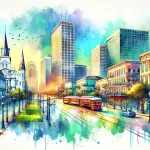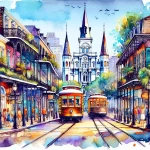Jackson Square, situated at the heart of New Orleans’ French Quarter, has been a central gathering place for the city since its establishment in 1721. This iconic landmark originally functioned as a military parade ground, open-air marketplace, and cultural hub, playing a pivotal role throughout its history.
In This Article
TL;DR
- Jackson Square showcases historic buildings that reflect French and Spanish architectural influences, including the St. Louis Cathedral, the Cabildo, and the Presbytère.
- The square is a haven for artists, musicians, and street performers, contributing to the unique ambiance of the French Quarter.
- Jackson Square has been instrumental in the development of New Orleans, serving as a gathering place for community events and attracting over 2 million visitors annually.
Historical Context of Jackson Square
The origins of Jackson Square date back to 1721, when French landscape architect Louis H. Pilié designed the layout of New Orleans’ colonial settlement, with Place d’Armes as its centerpiece. The square served as a military parade ground and public market under French and Spanish colonial rule. In 1803, the Louisiana Purchase was finalized in Jackson Square, marking the transfer of the Louisiana territory from France to the United States.
During the early 19th century, the square was renamed Jackson Square in honor of Andrew Jackson, the hero of the Battle of New Orleans and the seventh U.S. president. The square was also notorious for public executions, including the hanging of three slaves following the 1811 German Coast Uprising, the largest slave revolt in U.S. history.
Architectural Highlights of Jackson Square
The iconic St. Louis Cathedral, with its striking white façade and three spires, is the oldest continuously active cathedral in the United States. Flanking the cathedral are the Cabildo and the Presbytère, two historic buildings that now serve as Louisiana State Museums. The Cabildo, built in 1799, was the site of the Louisiana Purchase transfer ceremony and later served as the New Orleans City Hall. The Presbytère, constructed in 1813, initially housed the city’s Roman Catholic priests and later served as a courthouse.
The square is also bordered by the Pontalba Buildings, the oldest continuously rented apartments in North America. These red-brick, four-story buildings, built in the 1840s, feature shops and restaurants on the ground floor and residential apartments above.
Cultural Significance
Jackson Square is a hub for artists, musicians, and street performers, contributing to the lively and colorful atmosphere of the French Quarter. Visitors can enjoy live music, watch artists at work, and even have their portraits drawn by talented local artists. The square hosts several annual events and festivals, such as the French Quarter Festival and Caroling in Jackson Square, which attract thousands of visitors and showcase the city’s vibrant culture.
Art and Expression in Jackson Square
The tradition of street artists and performers in Jackson Square dates back to the late 19th century. Today, the square is home to an open-air artist colony, where painters, caricaturists, and portraitists display their work on the iron fence surrounding the square. Many notable artists have contributed to the square’s unique vibe over the years, and the art markets held in the square play a vital role in supporting local artisans.
Jackson Square’s Role in New Orleans’ Tourism
As one of New Orleans’ most recognizable landmarks, Jackson Square is a must-visit destination for tourists. The square’s central location in the French Quarter makes it easily accessible, and its proximity to other popular attractions, such as Café du Monde and the French Market, adds to its appeal. Visitors are advised to explore the square during the day, when artists and performers are most active, and to take in the stunning architecture and historical significance of the surrounding buildings.
Preservation and Conservation Efforts
Efforts to maintain and preserve the historical and aesthetic integrity of Jackson Square are ongoing, with local government and community organizations playing a crucial role. The square has undergone several renovations and improvements over the years, including façade repainting, building renovations, and landscaping enhancements carried out by the Works Progress Administration (WPA) during the 1930s. The challenges faced in preservation include balancing the needs of the community, tourists, and the historical significance of the site.
Jackson Square Today: A Living Legacy
Today, Jackson Square remains a vital part of New Orleans’ cultural landscape, serving as a gathering place for community and public events. The square’s enduring popularity is a testament to its ability to remain relevant in modern-day New Orleans while preserving its rich history. Ongoing projects and future prospects for the square aim to maintain its status as the heart of the French Quarter and a symbol of the city’s resilience and spirit.
Expert Insights and Future Outlook
Historians and local experts agree that Jackson Square will continue to play a significant role in shaping the cultural landscape of New Orleans. As the city evolves, the square will adapt to meet the changing needs of the community while preserving its historical and cultural significance. With proper care and management, Jackson Square is poised to remain an iconic landmark and a cherished gathering place for generations to come.
St. Louis Cathedral: 615 Pere Antoine Alley, New Orleans, LA 70116; (504) 525-9585; Open daily, 8:30 AM – 4:00 PM
The Cabildo: 701 Chartres St, New Orleans, LA 70116; (504) 568-6968; Open Tue-Sun, 10:00 AM – 4:30 PM
The Presbytère: 751 Chartres St, New Orleans, LA 70116; (504) 568-6968; Open Tue-Sun, 10:00 AM – 4:30 PM
Café du Monde: 800 Decatur St, New Orleans, LA 70116; (504) 525-4544; Open 24 hours a day, 7 days a week
Note: Hours and availability may vary due to holidays or special events. Please check with individual locations for the most up-to-date information.






